Electric reef
An electric reef is an artificial reef from biorock, a material formed on a metal structure by accretion of minerals dissolved in seawater in the presence of a small electric current. The first reefs of this type were created by Wolf Hilbertz and Thomas J. Goreau in the 1980s and by 2011 there were examples in over 20 countries.
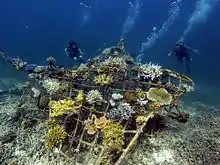
History
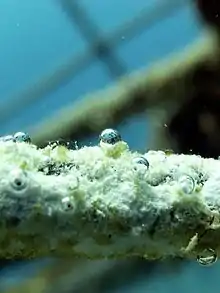
Artificial reefs have been built since the 1950s using materials including sunken ships, concrete blocks. Some artificial reefs succeeded, however, most of these failed to provide coral habitat and remain relatively barren compared with natural reefs.
Whilst studying how seashells and reefs grow in the 1970s Wolf Hilbertz discovered a simple method of creating 'Biorock' from minerals dissolved in seawater. Together with Thomas J. Goreau he realised that this process could be adapted to rapidly create artificial coral reefs during the 1980s.
With others, Hilbertz and Goreau made two expeditions to the Saya de Malha bank in 1997 and 2002. Using biorock technology, they attempted to grow an artificial island around steel structures that were anchored to the sea floor.[1] As "Seacrete" the process was publicised in a 1992 book of futurology, The Millennial Project. Author Marshall Savage reiterated Hilbertz' earlier proposal that the conductive metal magnesium be extracted from ocean water, and that the process use electricity from ocean thermal energy conversion. In 2012, both Goreau and Robert K. Trench, writing together with Goreau, published works on how biorock could generate building materials as well as restoring damaged ecosystems.[2] One prominent example was in the Maldives during the 1998 warming, during which fewer than 5% of the natural reef corals survived. On electric reefs there, 80% of corals flourished.[3]
Goreau continued the work after Hilbertz's death in 2007 and by 2011 there were electric reef projects installed in over 20 countries.[4]
Process
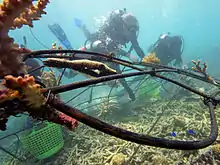

To build an electric reef, a welded, electrically conductive frame, often made from construction grade rebar or wire mesh, is submerged and attached to the sea bottom to which a low voltage direct current is applied that initiates an electrolytic reaction that precipitates mineral crystals naturally found in seawater, mainly calcium carbonate and magnesium hydroxide, on the structure. Within days, the structure takes on a whitish appearance as it becomes encrusted with precipitated minerals that add rigidity and strength. Electric fields, plus the shade and protection offered by the metal/limestone frame, soon attracts colonizing marine life, including fish, crabs, clams, octopus, lobster and sea urchins.
Once the structure is in place and minerals begin to coat the surface, the next phase of reef construction begins. Divers transplant coral fragments from other reefs, attaching them to the ark’s frame. Immediately, these coral pieces begin to bond to the accreted mineral substrate and because of evolved oxygen and the electrochemically facilitated accretion of dissolved ions, such as bicarbonate - start to grow—typically three to five times faster than normal. Soon the reef takes on the appearance and utility of a natural reef ecosystem rather than a man-made one.
Shore protection electric reef
Shorelines are highly susceptible to beach recession and loss due to climate change bringing about rising sea levels and increasingly frequent and powerful storms.
Conventional methods of combatting this employ large structures such as breakwaters that are designed to reflect waves, thus preventing erosion. However, these methods are problematic and may actually contribute to further beach erosion. As each wave crashes, the force it exerts on the structure is doubled due to the reversal of the wave direction vector. This reflected wave then carries the sand at the structure's base back out to sea. This repeats until the structure is dug out and falls, or breaks.[5]
Shore protection electric reefs are open mesh frameworks on which coral can grow and that dissipates the wave energy, thereby mimicking the effect of a natural reef which prevents erosion by dissipating around 97% of wave energy. Skeletons of dead coral and algae from the reef are then deposited and help grow beaches.[6][7]
Shore protection electric reefs mimic these natural reefs, reaping their benefits and solving some of the challenges they have in storm dissipation. The self-healing quality of Biorock ensures structures will survive even the most devastating storms.[6]
Shore protection electric reefs in Turks and Caicos survived the two worst hurricanes in the history of the islands, which occurred three days apart and damaged or destroyed 80% of the buildings on the island. Sand was observed to build up around the bases of Biorock reef structures.[6]
In Maldives in 1997, Shore protection reefs helped save several buildings, including a hotel, that had risked washing away due to severe beach erosion. The 50-meter-long shore protection reef stabilized and ultimately reversed erosion in several years, even allowing the beach to survive a tsunami in 2004.
Distribution
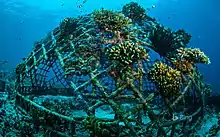
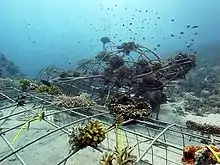
Electric reef projects had been installed in over 20 countries, in the Caribbean, Indian Ocean, Pacific and Southeast Asia. Projects are located in French Polynesia, Indonesia, Maldives, Mexico, Panama, Papua New Guinea, Seychelles, the Philippines, Thailand and on one of the most remote and unexplored reef areas of the world, the Saya de Malha Bank in the Indian Ocean.[4]
Indonesia has the most reef projects projects, with sites near over half a dozen islands, including the world's two largest reef restoration projects: Pemuteran with the Karang Lestari and the Gili islands with the Gili Eco Trust.[8]
Non-coral reef projects projects have been conducted in places such as Barataria Bay, Galveston, seagrasses in the Mediterranean, oyster reefs and salt marshes in New York City, in Port Aransas, and in St. Croix.
Effectiveness
Electrolysis of electric reefs enhances coral growth, reproduction and ability to resist environmental stress. Coral species typically found on healthy reefs gain a major advantage over the weedy organisms that often overgrow them on stressed reefs.
Biorock can enable coral growth and regrowth even in the presence of environmental stress such as rising ocean temperatures, diseases, and nutrient, sediment, and other types of pollution. Biorock represents the only known method that can sustain and grow natural coral species using only basic conducting elements, typically of a common metal such as steel.
The process accelerated growth on coral reefs by as much as fivefold and restoration of physical damage by as much as 20 times.[9][10] and the rate of growth can be varied by altering the amount of current flowing into the structure.
In one study, Porites colonies with and without an electric field were compared for 6 months after which time the current to the electric reef was eliminated. Growth differences were significant only during the first 4 months with longitudinal growth being relatively high in the presence of the field. The treatment corals survived at a higher rate.[11]
On Vabbinfaru island in the Maldives, a 12-meter, 2 ton steel cage called the Lotus was secured on the sea floor. As of 2012, coral was so abundant on the structure that the cage is difficult to discern. The 1998 El Nino killed 98% of the reef around Vabbinfaru. Abdul Azeez, who led the Vabbinfaru project, said coral growth on the structure is up to five times that of elsewhere. A smaller prototype device was in place during the 1998 warming event and more than 80% of its corals survived, compared to just 2% elsewhere.[12] However, power is no longer supplied to the project, leaving it vulnerable to the next round of bleaching.
Drawbacks
Electric reefs require electrical power to maintain them. In Maldives, several electric reefs successfully survived a 1998 bleaching event that killed off nearly all local wild coral, however after being depowered they were killed by the bleaching event of 2016.[6]
A study conducted in the Bahamas in 2015 showed that the electric field deterred sharks, specifically the bull shark and the Caribbean reef shark, from swimming and feeding in the area. The electric field is believed to affect sharks because of their electroreception abilities, however species with similar capabilities such as the bar jack and Bermuda chub did not appear to be affected by the electric field.[13]
See also
References
- "PDF of the Saya de Malha expedition 2002, rev. 1" (PDF).
- Goreau, Thomas J.; Trench, Robert Kent (4 December 2012). Innovative Methods of Marine Ecosystem Restoration. CRC Press. CRC Press. ISBN 9781466557734. Retrieved 6 October 2017.
- Goreau, T. J, A Solution for Corals in Peril, A GCRA Overview, GCRA website, April 2002
- Gutzeit, Frank + Hilbertz, W. H. + Goreau, T. J. (August 2002). "Saya de Malha Expedition, March 2002". Sun&Sea E.V. Hamburg.CS1 maint: multiple names: authors list (link)
- Goreau, Thomas J. Trench, Robert Kent. (2013). Innovative methods of marine ecosystem restoration. CRC Press. ISBN 978-1-4665-5773-4. OCLC 904531279.CS1 maint: multiple names: authors list (link)
- Goreau, Thomas J. F.; Prong, Paulus (December 2017). "Biorock Electric Reefs Grow Back Severely Eroded Beaches in Months". Journal of Marine Science and Engineering. 5 (4): 48. doi:10.3390/jmse5040048.
- Ferrario, Filippo; Beck, Michael W.; Storlazzi, Curt D.; Micheli, Fiorenza; Shepard, Christine C.; Airoldi, Laura (September 2014). "The effectiveness of coral reefs for coastal hazard risk reduction and adaptation". Nature Communications. 5 (1): 3794. Bibcode:2014NatCo...5.3794F. doi:10.1038/ncomms4794. ISSN 2041-1723. PMC 4354160. PMID 24825660.
- Goreau, T. J, comments quoted in Independent Study Project on Biorock, GCRA website, February 2011
- "Biorock, Mineral Accretion Technology, Seament". Global Coral Reef Alliance. Retrieved 27 January 2020.
- Ferrario, F. (2014). "The effectiveness of coral reefs for coastal hazard risk reduction and adaptation" (PDF). Nature Communications. 5: 3794. Bibcode:2014NatCo...5.3794F. doi:10.1038/ncomms4794. PMC 4354160. PMID 24825660 – via Nature.com.
- Sabater, Marlowe G.; Yap, Helen T. (November 2004). "Long-term effects of induced mineral accretion on growth, survival and corallite properties of Porites cylindrica Dana". Journal of Experimental Marine Biology and Ecology. 311 (2): 355–374. doi:10.1016/j.jembe.2004.05.013. ISSN 0022-0981.
- Vince, Gaia (6 September 2012). "How can we save our dying coral reefs?". bbc.com. BBC. Retrieved 12 August 2018.
- Uchoa, Marcella P.; O’Connell, Craig P.; Goreau, Thomas J. (1 January 2017). "The effects of Biorock-associated electric fields on the Caribbean reef shark (Carcharhinus perezi) and the bull shark (Carcharhinus leucas)". Animal Biology. 67 (3–4): 191–208. doi:10.1163/15707563-00002531. ISSN 1570-7563.
Further reading
- "Changes in zooxanthellae density, morphology, and mitotic index in hermatypic corals and anemones exposed to cyanide", 2003
- Goreau + Hilbertz: "Marine Ecosystem Restoration: Costs and benefits for coral reefs", World Resource Review, 2005
- Vaccarella, R. + Goreau: "Applicazione della elettrodeposizione nel recupero die mattes di Posidonia oceanica", 2008
- Goreau + Hilbertz, "Bottom-Up Community-Based Coral Reef and Fisheries Restoration in Indonesia, Panama, and Palau", 2008
- Goreau + Hilbertz, "Reef Restoration as a Fisheries Management Tool", UK 2008, on GCRA website
- Strömberg + Lundälv + Goreau: "Suitability of Mineral Accretion as a Rehabilitation Method for Cold-Water Coral Reefs", 2010
- "Effect of severe hurricanes on Biorock Coral Reef Restoration Projects in Grand Turk, Turks and Caicos Islands", 2010
- Goreau, T. J.: "Coral Reef and Fisheries Habitat Restoration in the Coral Triangle", Indonesia 2010
- Bakti, Lalu; Virgota, Arben; Damayanti, Luh; Radiman, Thri; Retnowulan, Ambar; Sabil, Abdus; Robbe, Delphine (4 December 2012). "Biorock Reef Restoration in Gili Trawangan, North Lombok, Indonesia". Innovative Methods of Marine Ecosystem Restoration. CRC Press. pp. 59–80. doi:10.1201/b14314-7. ISBN 9781466557734. Retrieved 13 August 2018.
External links
- "A New Future in Electric Coral Reefs". New Heaven Diving School. 23 August 2015.
- Global Coral Reef Alliance
- Biorock.net
- CCell Supplier of equipment